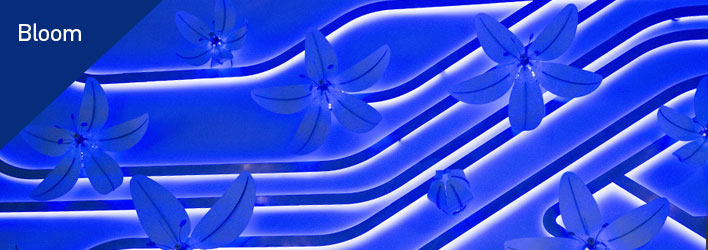Bloom

NTU Community
Mixed Media
H3000 x L11000 mm
2017
Bloom is inspired by the Combretum indicum (Quisqualis Indica Linn.), also known as the Chinese honeysuckle or Rangoon creeper. This sweet-smelling flower is often associated with positive qualities such as love, luck, protection and prosperity. The bloom emerges white, changes to pink and matures into deep red.
Conceptualised by students from NTU's School of Art, Design and Media, Bloom was refined by their project supervisor, Fabrizio Galli, a former member of the faculty at the same school. It was enhanced and completed with the use of renewable energy technology and the addition of electronic features by a project team from the Energy Research Institute at NTU (ERI@N) and Dennis Low of the NTU Museum. The installation, which comprises 18 flowers in three different sizes connected with vines, spans 11 meters in length and three meters in height.
Powered by renewable energy harvested by solar panels installed on the top of this building, Bloom is a fine example of an energy conservation and sustainable earth project. It aims to bring an awareness of conservation to the growing realm of art and design, the fundamental value of enhancing the built environment, and the innovative use of materials in contemporary art installations. The flowers come 'alive', their petals responding to visitors with rhythmic opening and closing movements. The accompanying LED lights under the tributary of the anodized aluminium vine structure interact with and respond to changing weather conditions outside by gradually changing colour from white and red to blue. Phase two of this project links the weather conditions on the main campus to Bloom and will be completed in 2018. This enhancement symbolically emphasise the strong connection between the two campuses.
Bloom is the fourth collaborative renewable energy artwork on the campus created by School of ADM, ERI@N and NTU Museum. The work was commissioned in 2016 as part of NTU Museum's Renewable Energy Art and Public Art initiatives. Three other renewable energy artworks are currently on display at the main campus.
Mixed Media
H3000 x L11000 mm
2017
Bloom is inspired by the Combretum indicum (Quisqualis Indica Linn.), also known as the Chinese honeysuckle or Rangoon creeper. This sweet-smelling flower is often associated with positive qualities such as love, luck, protection and prosperity. The bloom emerges white, changes to pink and matures into deep red.
Conceptualised by students from NTU's School of Art, Design and Media, Bloom was refined by their project supervisor, Fabrizio Galli, a former member of the faculty at the same school. It was enhanced and completed with the use of renewable energy technology and the addition of electronic features by a project team from the Energy Research Institute at NTU (ERI@N) and Dennis Low of the NTU Museum. The installation, which comprises 18 flowers in three different sizes connected with vines, spans 11 meters in length and three meters in height.
Powered by renewable energy harvested by solar panels installed on the top of this building, Bloom is a fine example of an energy conservation and sustainable earth project. It aims to bring an awareness of conservation to the growing realm of art and design, the fundamental value of enhancing the built environment, and the innovative use of materials in contemporary art installations. The flowers come 'alive', their petals responding to visitors with rhythmic opening and closing movements. The accompanying LED lights under the tributary of the anodized aluminium vine structure interact with and respond to changing weather conditions outside by gradually changing colour from white and red to blue. Phase two of this project links the weather conditions on the main campus to Bloom and will be completed in 2018. This enhancement symbolically emphasise the strong connection between the two campuses.
Bloom is the fourth collaborative renewable energy artwork on the campus created by School of ADM, ERI@N and NTU Museum. The work was commissioned in 2016 as part of NTU Museum's Renewable Energy Art and Public Art initiatives. Three other renewable energy artworks are currently on display at the main campus.














/enri-thumbnails/careeropportunities1f0caf1c-a12d-479c-be7c-3c04e085c617.tmb-mega-menu.jpg?Culture=en&sfvrsn=d7261e3b_1)

/cradle-thumbnails/research-capabilities1516d0ba63aa44f0b4ee77a8c05263b2.tmb-mega-menu.jpg?Culture=en&sfvrsn=1bc94f8_1)

7e6fdc03-9018-4d08-9a98-8a21acbc37ba.tmb-mega-menu.jpg?Culture=en&sfvrsn=7deaf618_1)
